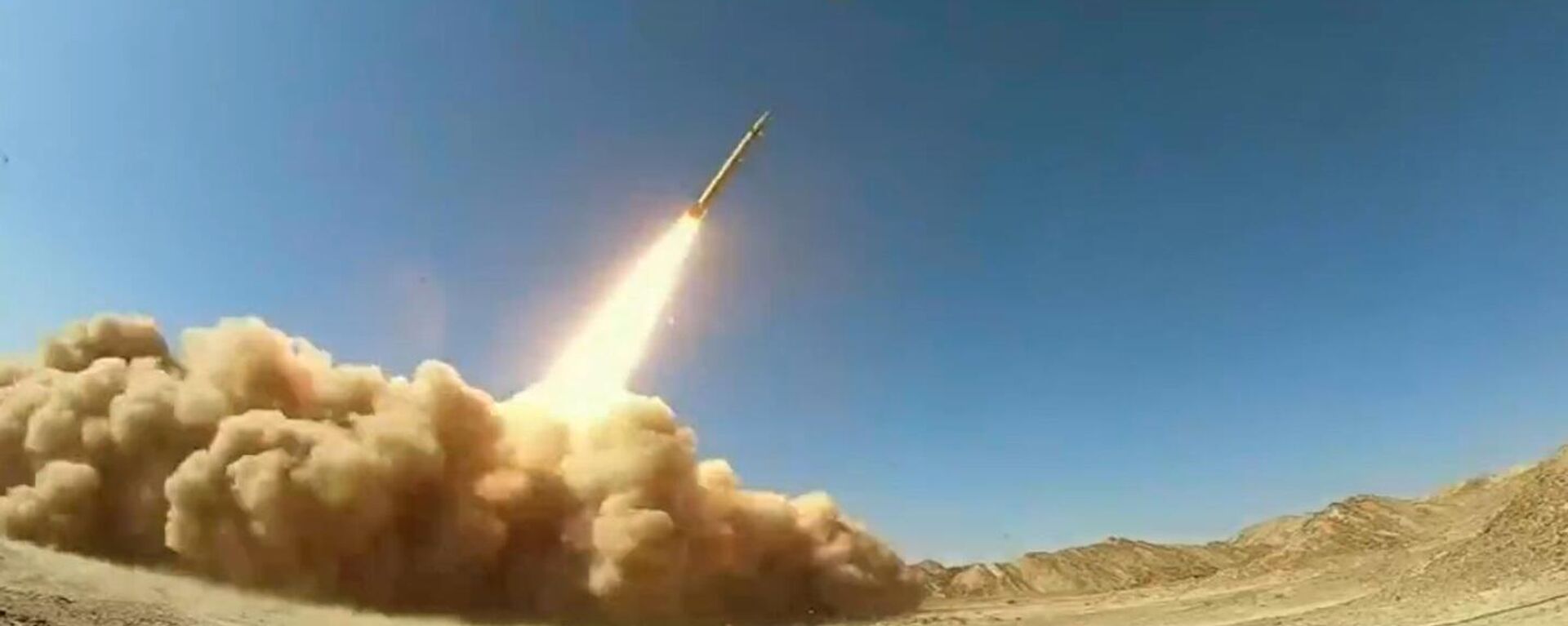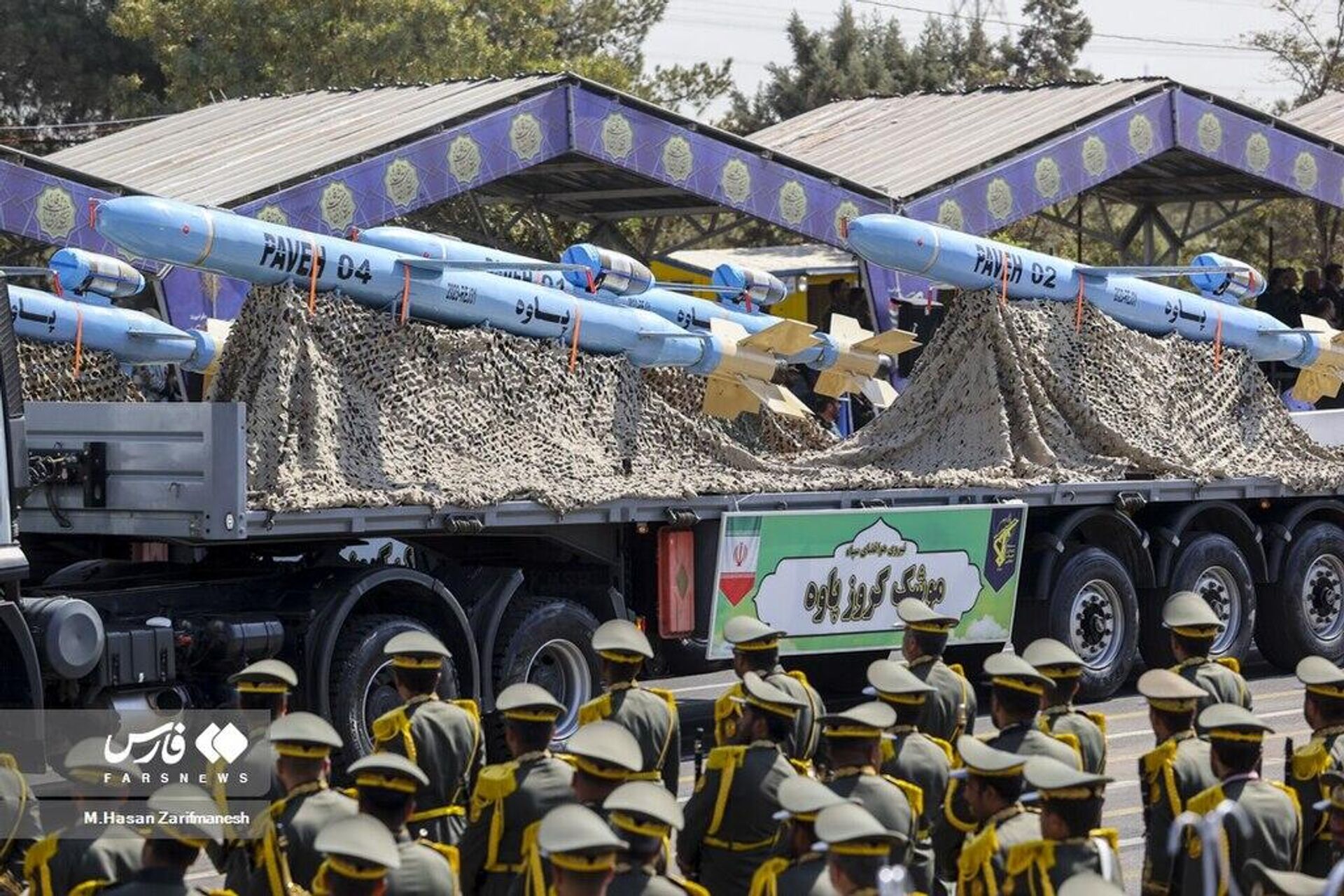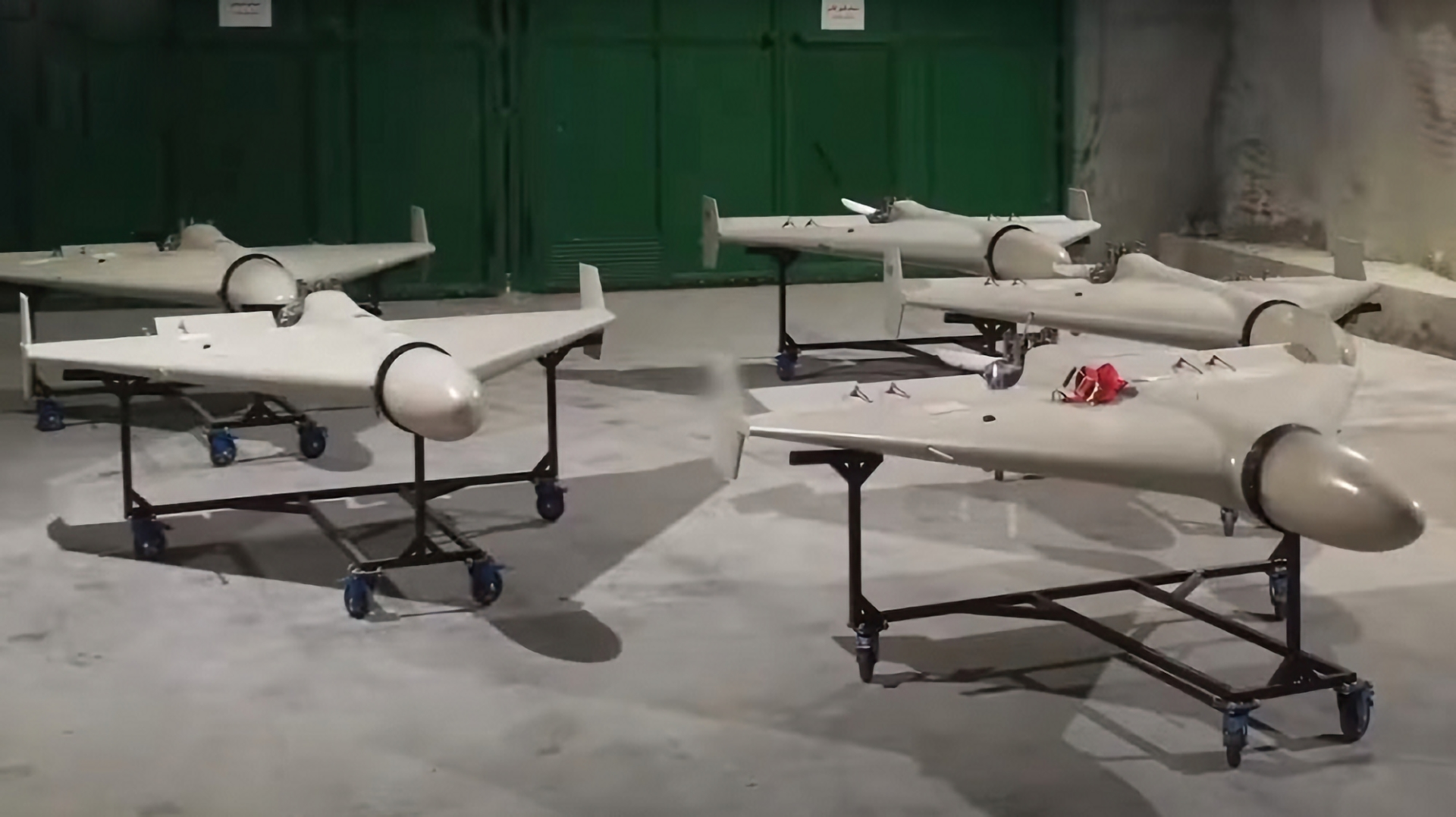https://sputnikglobe.com/20240421/iranian-media-reveals-advanced-missiles-iran-has-hidden-in-reserve-in-case-of-us-israeli-escalation-1118043117.html
Iranian Media Reveals Advanced Missiles Iran Has Hidden in Reserve in Case of US-Israeli Escalation
Iranian Media Reveals Advanced Missiles Iran Has Hidden in Reserve in Case of US-Israeli Escalation
Sputnik International
Last weekend’s Iranian drone, ballistic and cruise missile strikes on Israel were accompanied by conflicting reports about which capabilities the Islamic Republic used, and which ones it left in reserve. A new report by an authoritative Iranian news agency affiliated with the Islamic Revolutionary Guard Corps has sought to set the record straight.
2024-04-21T14:29+0000
2024-04-21T14:29+0000
2024-04-21T14:29+0000
military
middle east
iran
israel
islamic revolutionary guard corps (irgc)
missile
drone
ballistic missiles
cruise missiles
hypersonic missiles
https://cdn1.img.sputnikglobe.com/img/07e8/04/15/1118041312_0:160:3072:1888_1920x0_80_0_0_72d9ed092743ab3d0c052b037b127b27.jpg
Iran did not deploy its most sophisticated missile capabilities during its ‘Operation True Promise’ strikes on Israel on April 14, using older equipment mixed with a number of upgraded missile warheads to lift the fog of war regarding Israel’s air and missile defense potential. That’s according to a new analysis by Tasnim.According to the news agency’s information, the April 13-14 overnight strikes by the IRGC Aerospace Force – launched in response to Israel’s April 1 attack on the Iranian consulate in Damascus, achieved their goal of mapping Israeli defenses, with Tel Aviv and its allies proving unable to fully shield the military and intelligence sites targeted by Iran despite getting 72 hours advance warning time. The IRGC, accordingly, was able to get a glimpse of Israel’s air and missile defense capabilities at their strongest –backed up by the US, the UK, France and Jordan, using the tried and tested tactic of multiple waves of attacks using increasingly sophisticated weaponry.First WaveAs has been previously reported, last week’s strikes kicked off using Iran’s Shahed-136 kamikaze drones, which fly toward their target at speeds of about 185 km per hour, and are noisy and easy to detect thanks to their simple propeller engines. The more advanced Shahed-238s – a jet engine-powered variant of the Shahed-136, were not used, according to Tasnim, debunking earlier reporting in some media that the latter UAVs were deployed. The Shahed-238 has a reported top speed of at least 500 km per hour (some sources say 800 km/h), and features a coating which may be a radar-absorbent, according to OSINT analyses.The first wave of the attack was designed to distract Israeli and allied forces, forcing them to spend time finding and targeting the Shahed-136s in the night sky and engaging them instead of kicking off an immediate counterstrike into Iran (as some Israeli officials reportedly demanded at the time).Second WaveAfter the drones, the IRGC moved on to the second wave of its attack, which saw the firing of the Paveh – a long-range surface-to-surface smart cruise missile with retractable wings and the ability to change course and targets mid-flight.Fired from mobile truck launchers, these turbojet-powered engines have a reported range of over 1,000 km (other sources indicate 1,650 km) and a cruising speed of between 700 and 900 km/h. A number of Paveh missiles were used during last week’s strikes.Third WaveThe third and final wave of the attack began after midnight on April 14 Iranian time, and consisted of the firing of ballistic missiles that entered Israeli airspace minutes after launch. Tasnim’s analysis indicates that the IRGC did not play its “trump card” of using its most advanced missiles, including the Sejjil, Khorramshahr, Kheibar Shekan 2 or its new hypersonic Fatah series missiles, in the strikes.The Farsi-language version of Tasnim’s report offered further details on the ballistic missile strikes, noting that because of the distance between Iran and Israel, the Israeli military and its allies were unable to engage Iranian missiles in the acceleration or mid-flight phase of their approach using their sophisticated missile defense shield equipment.The report also confirmed an observation made by some independent military observers this week: that the ballistic missiles Iran used in the strikes “contained micro munition payloads, or fragmentation warheads,” which made it substantially more difficult for Israeli and US air and missile defenses to intercept them.Furthermore, Tasnim said, phenomena observed in footage moments before the warheads’ impact, including missile acceleration and change of direction while diving onto their targets, seem to indicate the use of boosters or some other type of acceleration means.Tasnim warned that if the crisis were to escalate now, Iran could repeat the tactics it used last week on a larger scale, this time firing a first wave of older projectiles to overwhelm Israeli air defenses, and then launching its most sophisticated missiles directly at air defenses, leaving its adversary defenseless.
https://sputnikglobe.com/20220210/watch-iran-unveil-new-castle-buster-missile-capable-of-hitting-israel-us-bases-across-middle-east-1092911711.html
iran
israel
Sputnik International
feedback@sputniknews.com
+74956456601
MIA „Rossiya Segodnya“
2024
News
en_EN
Sputnik International
feedback@sputniknews.com
+74956456601
MIA „Rossiya Segodnya“
Sputnik International
feedback@sputniknews.com
+74956456601
MIA „Rossiya Segodnya“
did iran fire hypersonic missiles, does iran have hypersonic missiles, what kind of missiles did iran use against israel, did israel shoot down iranian missiles
did iran fire hypersonic missiles, does iran have hypersonic missiles, what kind of missiles did iran use against israel, did israel shoot down iranian missiles
Iranian Media Reveals Advanced Missiles Iran Has Hidden in Reserve in Case of US-Israeli Escalation
Last weekend’s Iranian drone, ballistic and cruise missile strikes on Israel were accompanied by conflicting reports about which capabilities the Islamic Republic used, and which ones it left in reserve. A new report by an authoritative Iranian news agency affiliated with the Islamic Revolutionary Guard Corps has sought to set the record straight.
Iran did not deploy its most sophisticated missile capabilities during its ‘Operation True Promise’ strikes on Israel on April 14, using
older equipment mixed with a number of upgraded missile warheads to lift the fog of war regarding Israel’s air and missile defense potential. That’s according to a new analysis by Tasnim.
According to the news agency’s information, the April 13-14 overnight strikes by the IRGC Aerospace Force – launched in response to Israel’s April 1 attack on the Iranian consulate in Damascus,
achieved their goal of mapping Israeli defenses, with Tel Aviv and its allies proving unable to fully shield the military and intelligence sites targeted by Iran despite getting 72 hours advance warning time. The IRGC, accordingly, was able to get a glimpse of Israel’s air and missile defense capabilities at their strongest –backed up by the US, the UK, France and Jordan, using the tried and tested tactic of multiple waves of attacks using increasingly sophisticated weaponry.
As has been previously reported, last week’s strikes kicked off using Iran’s Shahed-136 kamikaze drones, which fly toward their target at speeds of about 185 km per hour, and are noisy and easy to detect thanks to their simple propeller engines.
The more advanced Shahed-238s – a jet engine-powered variant of the Shahed-136, were not used, according to Tasnim, debunking earlier reporting
in some media that the latter UAVs were deployed. The Shahed-238 has a reported top speed of at least 500 km per hour (some sources say 800 km/h), and features a coating which may be a radar-absorbent, according to OSINT analyses.
The first wave of the attack was designed to distract Israeli and allied forces, forcing them to spend time finding and targeting the Shahed-136s in the night sky and engaging them instead of kicking off an immediate counterstrike into Iran (as some Israeli officials reportedly demanded at the time).
After the drones, the IRGC moved on to the second wave of its attack, which saw the firing of the Paveh – a long-range surface-to-surface smart cruise missile with retractable wings and the ability to change course and targets mid-flight.
Fired from mobile truck launchers, these turbojet-powered engines have a reported range of over 1,000 km (other sources indicate 1,650 km) and a cruising speed of between 700 and 900 km/h. A number of Paveh missiles were used during last week’s strikes.
The third and final wave of the attack began after midnight on April 14 Iranian time, and consisted of the firing of ballistic missiles that entered Israeli airspace minutes after launch. Tasnim’s analysis indicates that the IRGC did not play its “trump card” of using its most advanced missiles, including the Sejjil, Khorramshahr, Kheibar Shekan 2 or its new hypersonic Fatah series missiles, in the strikes.
Instead, based on a review of missiles with sufficient range and striking power characteristics, the analysis noted that the IRGC was able to choose from the Dezful, Qiam-2, Rezvan, Kheibar Shekan 1, Emad and Qadr missiles for the strikes. These missiles have a range between 1,000 and 1,950 km, and all except the Dezful and Kheibar Shekan feature liquid fuel propulsion systems.

10 February 2022, 11:59 GMT
The
Farsi-language version of Tasnim’s report offered further details on the ballistic missile strikes, noting that because of the distance between Iran and Israel, the Israeli military and its allies were unable to engage Iranian missiles in the acceleration or mid-flight phase of their approach using their sophisticated missile defense shield equipment.
The US Aegis was said to be the only anti-missile system capable of engaging Iranian missiles flying outside the atmosphere – and even then using only one type of missile, and on the condition that sufficient radar data is available. Other equipment, both American and Israeli, including the Patriot, the THAAD, the Arrow-2 and 3, David’s Sling and the Iron Dome do not have sufficient capability to intercept the missiles at long ranges, the report said.
The report also confirmed an observation
made by some independent military observers this week: that the ballistic missiles Iran used in the strikes “contained micro munition payloads, or fragmentation warheads,” which made it substantially more difficult for Israeli and US air and missile defenses to intercept them.
“Such projectiles were illuminated in [published] videos, resembling a burning object or a component of a downed missile, while this type of projectile would scatter across various directions when it gets hit,” the news agency explained. “The utility for fragmentation warheads seems to have been aimed at attracting the thermal seekers of the air defense missiles or the ground-based thermal detection systems,” forcing the defenders to deplete anti-missile missile stocks, and ultimately overwhelming air defenses.
Furthermore, Tasnim said, phenomena observed in footage moments before the warheads’ impact, including missile acceleration and change of direction while diving onto their targets, seem to indicate the use of boosters or some other type of acceleration means.
In the final analysis, the report said that while Israel “will need months or even years to update its defense missile capabilities, Iran has [still not] played its trump card, such as the Kheibar Shekan 2, Fattah 1, Fattah 2 and Khorramshahr 4 missiles. Moreover, Iran is able to rapidly renovate its assault capabilities by only optimizing the warheads of its missiles, not redesigning them.”
Tasnim warned that if the crisis were to escalate now, Iran could repeat the tactics it used last week on a larger scale, this time firing a first wave of older projectiles to overwhelm Israeli air defenses, and then launching its most sophisticated missiles directly at air defenses, leaving its adversary defenseless.









